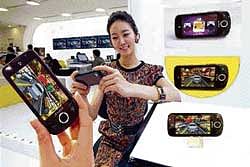A speeding car just jumped out of your cellphone

Smartphones are getting smarter. Now some new models even offer games or television broadcasts in three dimensions — and you don’t need special glasses to see the show.
Traditional 3-D technology used for movie screens and television superimposes or alternates two views, using filters or shutters in the glasses to select a view for each eye. This creates an illusion of depth. But a new generation of devices, many of them hand-held and now in prototype, dispense with the pesky glasses. Instead, they use optics and other technology built into the display to steer one view directly to the left eye, and the other view to the right.
Easy on small screen
Glasses-free 3-D effects are easier to produce on a small, portable screen than on a large, stationary one, said Paul Semenza, a senior vice president at the market researcher DisplaySearch in Santa Clara, California. That’s because the viewer can easily adjust the angle of the display by hand for the 3-D view.
The devices offer extra drama for sports broadcasts. Footballs or baseballs “seem to pop out of the display as through they were headed right toward you,” said Chris Chinnock, president of Insight Media. On mobile, 3-D works well for advertising, he said.
Samsung Electronics introduced its 3-D W960 touch-screen phone in May in South Korea, and customers are already using it to watch TV shows and music videos, said Eunju Hwang, a spokeswoman for the company in Seoul. Nokia has also demonstrated a 3-D cellphone and Hitachi is selling it in Japan.
The market for glasses-free, or “auto-stereoscopic,” 3-D is small right now, Semenza said, but will grow rapidly as the technology is incorporated into laptops, notebooks, digital cameras, camcorders, digital picture frames and game devices.
Many companies are competing to be part of this projected 3-D wave. For example, 3M in St Paul has developed an optical film coupled to banks of light-emitting diodes, said Erik Jostes, director of the company’s optical systems division. Microsoft has created a prototype for an auto-stereoscopic display that viewers needn’t adjust by hand to find the sweet spot. Instead, an unusual lens paired with cameras in the display keep track of where the viewer is, then steer separate, narrow columns of video to each eye, said Steven Bathiche, director of research for Microsoft’s applied sciences group.
The team of researchers is now working on a 240-hertz version with four beams of light, so that two people, for example, can watch 3-D shows. They will even be able to watch separate shows on the same television, he said, as the display steers one channel to one viewer and the other to the second.
Although the work is still in the early stages, Bathiche is looking forward to a commercial version of this device one day. Should that happen, fights over the remote may cease. “I can sit and watch sports,” he said, “and my wife can watch opera.”